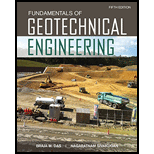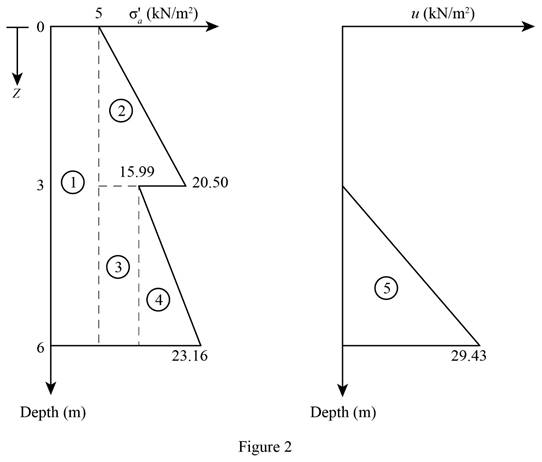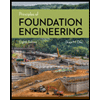
(a)
Find the Rankine’s active force per unit length of the wall.
Find the location of the resultant.
(a)
Answer to Problem 14.8P
The Rankine’s active force per unit length of the wall is
The location of the resultant is
Explanation of Solution
Given information:
The height (H) of the retaining wall is 3.05 m.
The depth
The unit weight
The saturated unit weight
The angle
The angle
The surcharge
Calculation:
Find the submerged unit weight
Here,
The unit weight
Substitute
The angle of internal friction above and below the water table is same. Therefore,
Find the coefficient of Rankine’s active earth pressure for frictionless wall
Substitute
Find the active earth pressure
Substitute
Find the active earth pressure
Substitute
Find the active earth pressure
Substitute
Find the pore water pressure
Substitute
Sketch the active earth pressure diagram as shown in Figure 1.

Find the active earth pressure per unit length at component 1
Substitute
Find the active earth pressure per unit length at component 2
Substitute
Find the active earth pressure per unit length at component 3
Substitute
Find the active earth pressure per unit length at component 4
Substitute
Find the total active earth pressure per unit length
Substitute
Therefore, the Rankine’s active force per unit length of the wall is
Refer Figure 1.
Find the location
Substitute
Find the location
Substitute
Find the location
Substitute
Find the location
Substitute
Find the location of resultant force
Take moment about the bottom of the wall.
Substitute
Therefore, the location of the resultant is
(b)
Find the Rankine’s active force per unit length of the wall.
Find the location of the resultant.
(b)
Answer to Problem 14.8P
The Rankine’s active force per unit length of the wall is
The location of the resultant is
Explanation of Solution
Given information:
The height (H) of the retaining wall is 6 m.
The depth
The unit weight
The saturated unit weight
The angle
The angle
The surcharge
Calculation:
Find the submerged unit weight
The unit weight
Substitute
Find the coefficient of Rankine’s active earth pressure for frictionless wall
Substitute
Find the coefficient of Rankine’s active earth pressure for frictionless wall
Substitute
Find the active earth pressure
Substitute
Find the active earth pressure
Substitute
Find the active earth pressure
Substitute
Find the active earth pressure
Substitute
Find the pore water pressure
Substitute
Sketch the active earth pressure diagram as shown in Figure 2.

Find the active earth pressure of component 1 per unit length due to surcharge load
Substitute
Find the active earth pressure per unit length at component 2
Substitute
Find the active earth pressure per unit length at component 3
Substitute
Find the active earth pressure per unit length at component 4
Substitute
Find the active earth pressure per unit length at component 5
Substitute
Find the total active earth pressure per unit length
Substitute
Therefore, the Rankine’s active force per unit length of the wall is
Refer Figure 1.
Find the location
Substitute
Find the location
Substitute
Find the location
Substitute
Find the location
Substitute
Find the location
Substitute
Find the location of resultant force
Take moment about the bottom of the wall.
Substitute
Therefore, the location of the resultant is
Want to see more full solutions like this?
Chapter 14 Solutions
Fundamentals of Geotechnical Engineering (MindTap Course List)
- A braced wall is shown in Figure 14.20. Given: H = 7 m, naH = 2.8 m, =30, =20, = 18 kN/m3, and c = 0. Determine the active thrust, Pa, on the wall using the general wedge theory. Figure 14.20arrow_forward3) A retaining wall is illustrated IN THE Figure. Determine the Rankine active force, (Pa) per unit length of the wall and the location of the resultant. H = 9 m, H1 = 4 m, Υ1 = 16.5 kN/m3, Υ2 = 20.2 kN/m3, ø'1 = 30, ø'2 = 34, q= 21 kN/m2arrow_forwardUse Eq. (12.3), Figure P12.2, and the following values to determine the at-rest lateral earth force per unit length of the wall. Also find the location of the resultant. H = 5 m, H1 = 2 m, H2 = 3 m, γ = 15.5 kN/m3, γsat = 18.5 kN/m3, Φ' = 34º, c' = 0, q = 20 kN/m2, and OCR = 1.arrow_forward
- 45.) A retaining wall supports a horizontal backfill that is composed of two types of soil. First layer: 5.91 meters high, Unit weight of 17.26 kN/m3, coefficient of active pressure of 0.291 Second layer: 5.36 meters high, Unit weight of 18.85 kN/m3, coefficient of active pressure of 0.301 Determine the distance of the total active force measured from the bottom of the wall. Round off to three decimal places.arrow_forwardA 10-m retaining wall is shown in figure A, determine: a. The active thrust on the wall due to soil and water b. The active thrust on the wall due to soil only [dry] c. The increase in force on the wall if the soil is fully saturated with rainwater.arrow_forwardA retaining wall 7 m high, with its back face smooth and vertical. It retains sand with its surface horizontal. Using Rankine’s theory, determine the active earth pressure at the base when the backfill is submerged with water table at the surface. Take γ=18 kN/m^3 ,ϕ=30°, γ_sat=21 kN/m^3.arrow_forward
 Fundamentals of Geotechnical Engineering (MindTap...Civil EngineeringISBN:9781305635180Author:Braja M. Das, Nagaratnam SivakuganPublisher:Cengage Learning
Fundamentals of Geotechnical Engineering (MindTap...Civil EngineeringISBN:9781305635180Author:Braja M. Das, Nagaratnam SivakuganPublisher:Cengage Learning Principles of Foundation Engineering (MindTap Cou...Civil EngineeringISBN:9781305081550Author:Braja M. DasPublisher:Cengage Learning
Principles of Foundation Engineering (MindTap Cou...Civil EngineeringISBN:9781305081550Author:Braja M. DasPublisher:Cengage Learning Principles of Geotechnical Engineering (MindTap C...Civil EngineeringISBN:9781305970939Author:Braja M. Das, Khaled SobhanPublisher:Cengage Learning
Principles of Geotechnical Engineering (MindTap C...Civil EngineeringISBN:9781305970939Author:Braja M. Das, Khaled SobhanPublisher:Cengage Learning Principles of Foundation Engineering (MindTap Cou...Civil EngineeringISBN:9781337705028Author:Braja M. Das, Nagaratnam SivakuganPublisher:Cengage Learning
Principles of Foundation Engineering (MindTap Cou...Civil EngineeringISBN:9781337705028Author:Braja M. Das, Nagaratnam SivakuganPublisher:Cengage Learning



